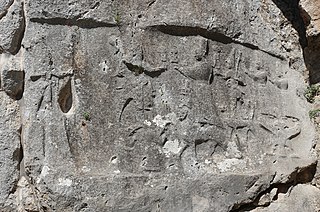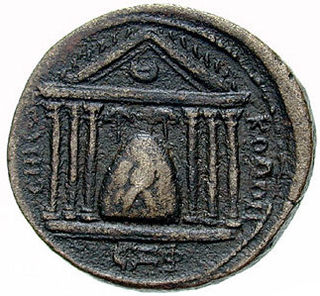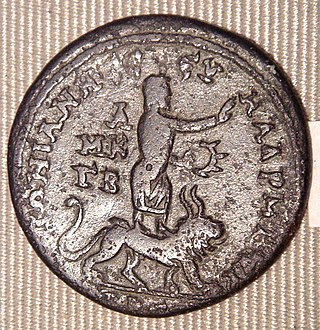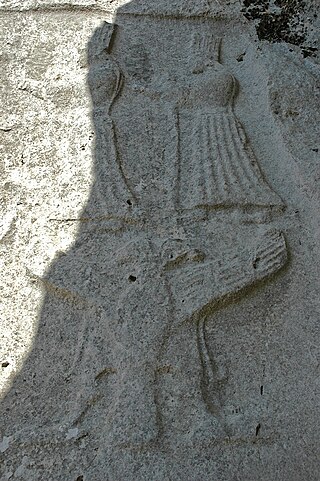Related Research Articles

Teshub was the Hurrian weather god, as well as the head of the Hurrian pantheon. The etymology of his name is uncertain, though it is agreed it can be classified as linguistically Hurrian. Both phonetic and logographic writings are attested. As a deity associated with the weather, Teshub could be portrayed both as destructive and protective. Individual weather phenomena, including winds, lightning, thunder and rain, could be described as his weapons. He was also believed to enable the growth of vegetation and create rivers and springs. His high position in Hurrian religion reflected the widespread importance of weather gods in northern Mesopotamia and nearby areas, where in contrast with the south agriculture relied primarily on rainfall rather than irrigation. It was believed that his authority extended to both mortal and other gods, both on earth and in heaven. However, the sea and the underworld were not under his control. Depictions of Teshub are rare, though it is agreed he was typically portrayed as an armed, bearded figure, sometimes holding a bundle of lightning. One such example is known from Yazılıkaya. In some cases, he was depicted driving in a chariot drawn by two sacred bulls.

Ḫepat was a goddess associated with Aleppo, originally worshiped in the north of modern Syria in the third millennium BCE. Her name is often presumed to be either a feminine nisba referring to her connection to this city, or alternatively a derivative of the root ḫbb, "to love". Her best attested role is that of the spouse of various weather gods. She was already associated with Adad in Ebla and Aleppo in the third millennium BCE, and in later times they are attested as a couple in cities such as Alalakh and Emar. In Hurrian religion she instead came to be linked with Teshub, which in the first millennium BCE led to the development of a tradition in which she was the spouse of his Luwian counterpart Tarḫunz. Associations between her and numerous other deities are described in Hurrian ritual texts, where she heads her own kaluti, a type of offering lists dedicated to the circle of a specific deity. She commonly appears in them alongside her children, Šarruma, Allanzu and Kunzišalli. Her divine attendant was the goddess Takitu. In Hittite sources, she could sometimes be recognized as the counterpart of the Sun goddess of Arinna, though their respective roles were distinct and most likely this theological conception only had limited recognition. In Ugarit the local goddess Pidray could be considered analogous to her instead.
Kumarbi, also known as Kumurwe, Kumarwi and Kumarma, was a Hurrian god. He held a senior position in the Hurrian pantheon, and was described as the "father of gods". He was portrayed as an old, deposed king of the gods, though this most likely did not reflect factual loss of the position of the head of the pantheon in Hurrian religion, but only a mythological narrative. It is often assumed that he was an agricultural deity, though this view is not universally accepted and the evidence is limited. He was also associated with prosperity. It was believed that he resided in the underworld.

Kušuḫ, also known under the name Umbu, was the god of the moon in Hurrian pantheon. He is attested in cuneiform texts from many sites, from Hattusa in modern Turkey, through Ugarit, Alalakh, Mari and other locations in Syria, to Nuzi, located near modern Kirkuk in Iraq, but known sources do not indicate that he was associated with a single city. His name might be derived from the toponym Kuzina, possibly the Hurrian name of Harran, a city in Upper Mesopotamia, but both this etymology and identification of this sparsely attested place name remain uncertain. He was a popular, commonly worshiped god, and many theophoric names invoking him are known. In addition to serving as a divine representation of the moon, he was also associated with oaths, oracles and pregnancy. Some aspects of his character were likely influenced by his Mesopotamian counterpart Sin, while he in turn was an influence on the Ugaritic god Yarikh and Luwian Arma.

Pinikir, also known as Pinigir, Pirengir, Pirinkir, and Parakaras, was an Ancient Near Eastern astral goddess who originates in Elamite religious beliefs. While she is only infrequently attested in Elamite documents, she achieved a degree of prominence in Hurrian religion. Due to her presence in pantheons of many parts of the Ancient Near East, from Anatolia to Iran, modern researchers refer to her as a "cosmopolitan deity."
Ḫašamili was a god worshiped in Bronze Age Anatolia. He originated in religious beliefs of the Hattians, and later came to be incorporated into the Hittite, Palaic and Luwian pantheons. He was regarded as a protective household deity, and was additionally associated with metalworking. He appears in the myth of Ḫaḫḫima, but his role in it is not fully understood.

A baetyl, literally "house of god" is a sacred stone that was venerated and thought to house a god or deity. The most famous example is the Omphalos stored in the Temple of Apollo at the Greek town of Delphi.

Hittite mythology and Hittite religion were the religious beliefs and practices of the Hittites, who created an empire centered in what is now Turkey from c. 1600–1180 BC.

Šauška (Shaushka), also called Šauša or Šawuška, was the highest ranked goddess in the Hurrian pantheon. She was associated with love and war, as well as with incantations and by extension with healing. While she was usually referred to as a goddess and with feminine titles, such as allai, references to masculine Šauška are also known. The Hurrians associated her with Nineveh, but she was also worshiped in many other centers associated with this culture, from Anatolian cities in Kizzuwatna, through Alalakh and Ugarit in Syria, to Nuzi and Ulamme in northeastern Mesopotamia. She was also worshiped in southern Mesopotamia, where she was introduced alongside a number of other foreign deities in the Ur III period. In this area, she came to be associated with Ishtar. At a later point in time, growing Hurrian influence on Hittite culture resulted in the adoption of Šauška into the Hittite state pantheon.
Aruna was the god of the sea in Hittite religion. His name is identical with the Hittite word for the sea, which could also refer to bodies of water, treated as numina rather than personified deities. His worship was not widespread, and most of the known attestations of it come exclusively from the southeast of Anatolia. He was celebrated in cities such as Ḫubešna and Tuwanuwa.
Alalu or Alala was a primordial figure in Mesopotamian and Hurrian mythology. He is also known from documents from Emar, where he was known as Alal. While his role was not identical in these three contexts, it is agreed that all three versions share the same origin. Hurrian Alalu, who plays the role of the oldest king of gods in the Kumarbi Cycle, is the best known, and is commonly discussed in scholarship focused on comparative mythology but it is agreed Mesopotamian Alala represents the oldest tradition regarding this being. However, the precise etymology of his name is unknown, and likely neither Sumerian nor Semitic. Both Hurrian and Mesopotamian sources attest an association between him and Anu, but its nature varies between cultures.

Šanta (Santa) was a god worshiped in Bronze Age Anatolia by Luwians and Hittites. It is presumed that he was regarded as a warlike deity, and that he could additionally be associated with plagues and possibly with the underworld, though the latter proposal is not universally accepted. In known texts he frequently appears alongside Iyarri, a deity of similar character. He is first attested in documents from Kanesh dated to the Old Assyrian period, and continues to appear in later treaties, ritual texts and theophoric names. He is also present in an offering lists from Emar written in Akkadian, though he did not belong to the local pantheon and rituals involving him were only performed on behalf of the Hittite administration by local inhabitants.

The Hurrian religion was the polytheistic religion of the Hurrians, a Bronze Age people of the Near East who chiefly inhabited the north of the Fertile Crescent. While the oldest evidence goes back to the third millennium BCE, it is best attested in cuneiform sources from the second millennium BCE written not only in the Hurrian language, but also Akkadian, Hittite and Ugaritic. It was shaped by contacts between the Hurrians and the various cultures with which they coexisted. As a result, the Hurrian pantheon included both natively Hurrian deities and those of foreign origin, adopted from Mesopotamian, Syrian, Anatolian and Elamite beliefs. The culture of the Hurrians was not entirely homogeneous, and different local religious traditions are documented in sources from Hurrian kingdoms such as Arrapha, Kizzuwatna and Mitanni, as well as from cities with sizeable Hurrian populations, such as Ugarit and Alalakh.

Ninatta and Kulitta were a dyad of Hurrian goddesses regarded as the handmaidens of Šauška. They were primarily considered divine musicians, though they also had a warlike aspect. They are attested in western Hurrian sources from Ugarit and Hattusa. They were also incorporated into the Hittite and Mesopotamian pantheons.
Goddess of the Night (Sumerian: 𒀭𒈪, DINGIR.GE6) was a deity worshiped in the Hurrian kingdom of Kizzuwatna, and later also in Šamuḫa in the Hittite Empire. Only the logographic writing of her name is known, and multiple attempts at identifying her have been made. Most researchers assume that she was at least partially similar to goddesses such as Ishtar, Šauška and Išḫara. She most likely represented the night sky, and was also associated with dreaming.
Takitu, Takiti or Daqitu was a Hurrian goddess who served as the sukkal of Ḫepat. She appears alongside her mistress in a number of Hurrian myths, in which she is portrayed as her closest confidante. Her name is usually assumed to have its origin in a Semitic language, though a possible Hurrian etymology has also been proposed. She was worshiped in Hattusa, Lawazantiya and Ugarit.

Allanzu, later known under the name Alasuwa, was a Hurrian goddess regarded as a daughter of Ḫepat. She was described as a youthful deity and in known texts often appears in association with her mother and siblings. She was also worshiped by Hittites and Luwians.
Tiyaz or Tiyad was the sun god of the Palaians, regarded as the third most important deity in their pantheon. He was also incorporated into Hittite religion. He appears in a ritual written in Palaic, though presumed to belong to a Hittite corpus, in which he is implored to anoint the king. After the fall of the Hittite Empire, he might have been worshiped by Phrygians.
Iyaya was a Hittite and Luwian goddess. Her functions remain uncertain, though it has been suggested she was associated with water or more broadly with nature. She might have been associated with the god Šanta, though the available evidence is limited. Her main cult centers were Lapana and Tiura, though she was also worshiped in other cities.

Hurrian primeval deities were regarded as an early generation of gods in Hurrian mythology. A variety of Hurrian, Hittite and Akkadian labels could be used to refer to them. They were believed to inhabit the underworld, where they were seemingly confined by Teshub. Individual texts contain a variety of different listings of primeval deities, with as many as thirty names known, though many are very sparasely attested. Some among them were received from Mesopotamia, but others might have names originating in Hurrian or a linguistic substrate. No specific cult centers of the primeval deities have been identified, and they were not worshiped by all Hurrian communities. They were also incorporated into Hittite religion, presumably either from Kizzuwatna or Syria. Offers were made to them in sacrificial pits, examples of which have been identified in Urkesh and Hattusa. The primeval deities also appear in a number of Hurrian myths, including multiple sections of the Kumarbi Cycle and the Song of Release.
References
Citations
- ↑ Laneri 2024, p. 180.
- ↑ Marinatos 2010, p. 87.
- ↑ Bryce, Trevor (2002). Life and Society in the Hittite World. Oxford University Press. p. 156. ISBN 978-0-19-924170-5.
- ↑ Becchio, Bruno; Schadé, Johannes P. (2006). Encyclopedia of World Religions. Foreign Media Group. p. 429. ISBN 978-1-60136-000-7.
- ↑
- Beckman, Gary (2011). "Primordial Obstetrics. "The Song of Emergence" (CTH 344)". Hethitische Literatur: Überlieferungsprozesse, Textstrukturen, Ausdrucksformen und Nachwirken: Akten des Symposiums vom 18. bis 20. Februar 2010 in Bonn. Münster: Ugarit-Verlag. ISBN 978-3-86835-063-0. OCLC 768810899.
Sources
- Laneri, Nicola (2024). From Ritual to God in the Ancient Near East: Tracing the Origins of Religion. Cambridge University Press.
- Marinatos, Nanno (2010). Minoan Kingship and the Solar Goddess: A Near Eastern Koine. University of Illinois Press.